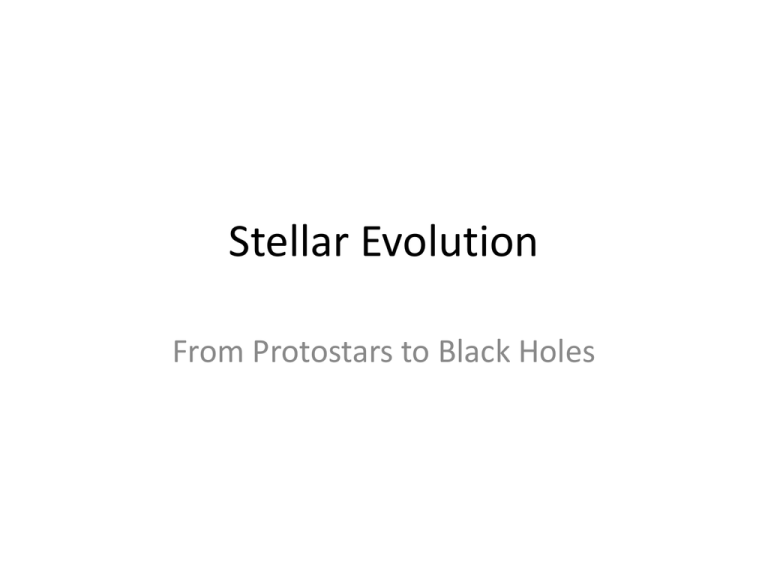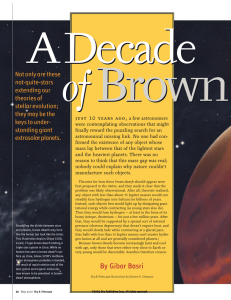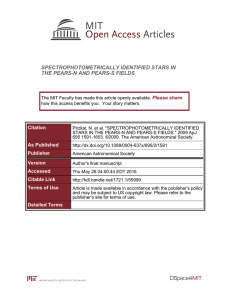Team_K_Stellar_Evolution
advertisement

Stellar Evolution From Protostars to Black Holes Absolute magnitude/Spectral type 0 – Hypergiants Ia, Ib – Super-giants II – Bright Giants III – Giants IV – Sub-giants V – Main Sequence VI – Sub-dwarfs VII – White dwarfs Hertzsprung-Russel diagram Young Stars • Protostars – Condensed, super-hot gas clouds • Hydrogen fusion – More massive stars reach about 10 million Kelvin thus allowing the fusion of Hydrogen – Star enters the Main Sequence • Brown dwarfs – Less massive stars never hot enough for nuclear fusion of Hydrogen to occur – Around 0.0125 solar masses – Stars below this mass are sub-brown dwarfs (classified as planets if orbiting a stellar object) Mature Stars • Once a star runs out of Hydrogen, it leaves the main sequence • Either – core becomes hot enough to fuse Helium – Electron degeneracy pressure balances gravitational forces causing stability Which process occurs depends upon the mass of the star. Low-mass stars • Red dwarfs – low temperature, low intensity • Post-fusion behaviour has not been observed due to the age of the universe • Models suggest – Red dwarfs of 0.1 solar mass could stay on main sequence for 6-12 trillion years – Could take hundreds of billions of years to collapse into White dwarfs Medium-size stars • 0.5-10 solar masses -> Red Giants • Accelerated fusion in outer layers causes expansion • Furthest out layers begin to cool so star becomes more red • Red-giant-branch phase – inert Helium core • Asymptotic-giant-branch phase – inert Carbon core Massive stars • Red Supergiants – brighter than red giants, hotter • Unlikely to survive -> Supernova • Extremely massive stars lose envelope gasses due to rapid stellar winds – Do not expand into super giants – Maintain very high surface temperatures (blue/white colour) Star Collapse • Temperatures are high enough that the star can fuse elements up to Iron • Once the process reaches Iron-56, it begins to consume energy • If the core mass exceeds the Chandrasekhar limit (2.765 × 1030 kg), the star will collapse to form a Neutron star • Exceeding the Tolman– Oppenheimer–Volkoff limit, (1.5-3.0 solar masses) leads to the formation of a Black Hole Supernova • • • • A star collapse is accompanied by a supernova Explosion brighter than a galaxy Lasts for a few weeks Radiation burst expels star’s material at about 30,000 km/s • Leaves behind a gas and dust cloud – Supernova Remnant Stellar Remnants • White and Black dwarfs – 0.6 solar mass compressed to the size of the Earth – Extremely hot (100,000 K at surface) – Once all material is burned, a cold, dark star is formed – Black dwarf (yet to be observed) • Neutron Stars – – – – core collapse -> electron capture, protons -> neutrons Radius ~10km, incredibly dense Rotational period of less than a few seconds Radiation pulses can be detected from each revolution, range from radio to gamma rays (pulsars) • Black Holes








